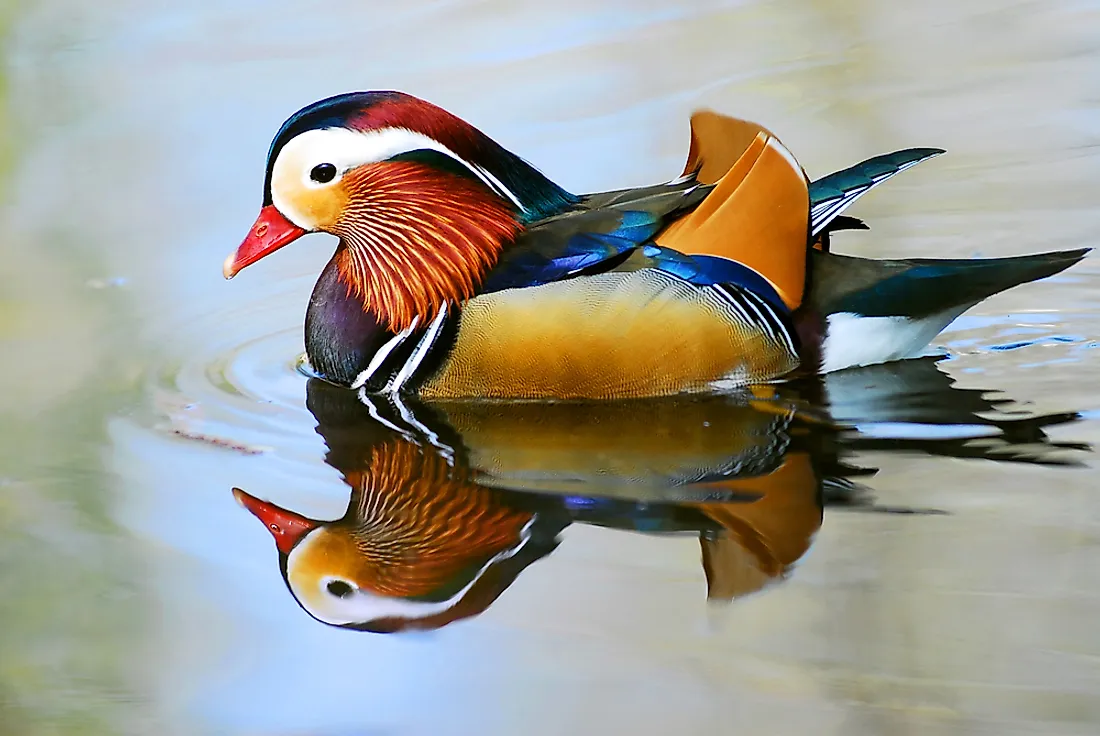Mandarin Duck Facts: Animals of Asia

5. Physical Description
Mandarin ducks (Aix galericulata) are famous for the gorgeous, colourful appearance of their males. The male duck adorns a dramatic display of colors, including that of its iconic red beak, its multihued crest with overlapping shades of black, green, blue and copper colors, and an overall golden appearance, with bright, golden-orange feathers hanging down the neck like a mane. A crescent-shaped white lining surrounds the eyes and extends to the sides of the neck. The feathers in the lower breast and belly region are whitish, while the feathers on the dorsal side are olive-brown in color. A pair of golden-orange wings extend out from the back of the duck while sitting. These act like sails when the bird floats or swims in the water. The female Mandarin ducks are, in contrast to the males, comparatively simple, and much less dramatic in appearance. Their body is largely covered by buff- and grey-colored feathers. The head is also grey, with a grey beak and crest, and a narrow white eye-ring extending from around the eyes to the back of the neck. The size of Mandarin ducks ranges between 8.3 and 9.7 inches (21.0-24.5 centimeters). The average weight of males is around 1.4 pounds (0.63 kilograms) and that of females is around 2.4 pounds (1.08 kilograms).
4. Diet
The diet of Mandarin ducks varies according to the season. In summer, the ducks feed on small, aquatic fauna like frogs, dew worms, tiny fishes, and, sometimes, even small snakes. In the autumn and winter seasons, the ducks primarily depend on a plant-based diet, feeding on acorns and grains. In spring, they have a mixed diet consisting of both plant and animal sources of food, including seeds, insects, and snails alike. While foraging, the Mandarin ducks either dabble in the water or walk on the land.
3. Habitat and Range
The Mandarin ducks were native to China, south-east Russia, Korea and Japan. On popular demand for their beauty, they were exported to many countries worldwide. Currently, their largest populations occur in Japan and Britain. Escape from captivity led to the growth of feral populations of Mandarin ducks as introduced species in many regions, including Britain, Ireland, Germany, and northern California in the US. The Mandarin ducks prefer to inhabit water bodies lining dense, shrubby, forested lands. They are thus found in ponds, lakes, rivers, marshes and swamps with plenty of emergent vegetation. Although these ducks are primarily found in freshwater, they can also be spotted in coastal lagoons and estuaries, especially during the winter season. Large scale exports, hunting, and degradation of habitat of the Mandarin ducks have led to a significant decline in the numbers of this species within their native habitats. Only about 1,000 pairs of these beautiful creatures survive in their Russian and Chinese homelands today. The most important natural predators of these ducks include feral dogs, minks, and Eurasian eagle-owls.
2. Behavior
Mandarin ducks usually feed during dawn and at dusk. They spend most of the rest of the day perching atop trees near the water bodies. Their wings are large compared to their body sizes, and hence they are able to swiftly take off from the water during times of danger. The males make whistling sounds or grunts, while females producer softer vocal tones. The males raise their crest as a courtship display, or during times of disturbance, but this behavior is not exhibited by females.
1. Reproduction
Mandarin ducks usually breed during the spring season. These creatures become sexually mature at about one year of age. The courtship period of these ducks is filled with dramatic displays and aggressive behavior. The males will ferociously compete with other males in efforts to win over a female duck. They whistle, bark, strut and puff around to catch the attention of the opposite sex. Mating takes place in the water and, if both partners survive, they are likely to mate again in the next season. The nesting site is chosen by the female, and is usually located inside a tree cavity near a source of water. This nest might be reused by the female throughout the entire period of her life. A total of between 8 and 10 eggs are normally laid by the female, spanning a period of approximately 6 to 7 days. The eggs are not incubated until all of them have been laid, which ensures a synchronous hatching time for all of the eggs. After a period of 30 days, the hatchlings emerge, and soon thereafter they become ready to come out of the hollow of their nest using their sharp claws. When deemed ready, they are called to the ground by the mother duck and, in response, jump out of the tree to reach the ground. The male Mandarin duck keeps the company of the female throughout the nesting period, up to around two weeks after the eggs have hatched. Even though the baby Mandarins are well guarded by their parents, only a few will normally manage to survive to adulthood.











